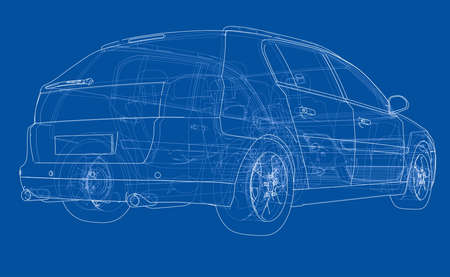1. Overview of Advanced Driver Assistance Systems (ADAS)
What Are Advanced Driver Assistance Systems?
Advanced Driver Assistance Systems, commonly known as ADAS, are a set of electronic technologies that assist drivers in driving and parking functions. These systems use sensors, cameras, and onboard computers to monitor the vehicle’s environment, alert drivers to potential hazards, and sometimes even take control of the vehicle to prevent accidents. In recent years, ADAS has become a standard feature in many new vehicles sold across the United States.
Common ADAS Features in Modern U.S. Vehicles
Today’s cars are equipped with various ADAS features designed to enhance safety and make driving more convenient. The table below summarizes some of the most popular ADAS features found in modern American vehicles:
| Feature | Description | Main Benefit |
|---|---|---|
| Adaptive Cruise Control (ACC) | Automatically adjusts speed to maintain a safe distance from the car ahead. | Reduces driver fatigue on highways and improves safety. |
| Lane Keeping Assist (LKA) | Helps keep the vehicle centered within its lane by gently steering if it detects drifting. | Prevents unintentional lane departure. |
| Automatic Emergency Braking (AEB) | Detects obstacles ahead and applies brakes if the driver does not react in time. | Minimizes collision risk and severity. |
| Blind Spot Monitoring (BSM) | Alerts drivers if another vehicle is in their blind spot during lane changes. | Improves awareness and reduces side-swipe accidents. |
| Rear Cross Traffic Alert (RCTA) | Warns drivers of approaching traffic while backing up. | Makes parking lots safer and easier to navigate. |
| Traffic Sign Recognition | Identifies road signs such as speed limits and displays them on the dashboard. | Keeps drivers informed about traffic rules in real time. |
The Importance of ADAS for Road Safety and User Convenience
ADAS plays a crucial role in making roads safer for everyone. By providing timely warnings or even taking corrective actions, these systems help reduce human error—the leading cause of most traffic accidents. In addition to safety benefits, ADAS features also add convenience for everyday drivers. For example, adaptive cruise control makes long highway drives less tiring, while parking assistance helps with challenging maneuvers in crowded urban areas. As technology advances, we can expect even more intelligent systems that further improve both safety and user experience on American roads.
2. The Evolution of AI and Machine Learning in Automotive Tech
Artificial Intelligence (AI) and Machine Learning (ML) have become game-changers in the automotive industry, especially when it comes to Advanced Driver Assistance Systems (ADAS). Over the past decade, these technologies have shifted from experimental concepts to essential components in modern vehicles. Their integration has shaped how cars sense, process, and respond to real-world driving situations, making roads safer and drivers more confident.
From Basic Sensors to Intelligent Systems
In the early days, ADAS relied on basic sensors like cameras, radar, and ultrasonic devices that could only provide simple alerts or limited automation. However, as AI and ML entered the scene, these systems gained the ability to analyze vast amounts of data in real time. This means your car can now recognize pedestrians, interpret traffic signs, and even predict potential hazards before they happen.
How AI and Machine Learning Transform ADAS
| Traditional ADAS | AI & ML-Driven ADAS |
|---|---|
| Relies on pre-programmed rules | Learns from real-world data |
| Limited object recognition | Advanced object detection (cars, bikes, people) |
| Basic lane-keeping features | Adaptive lane centering using pattern recognition |
| No predictive abilities | Predicts driver behavior and road risks |
The Building Blocks: Data and Connectivity
AI-powered ADAS systems collect data from multiple sources—cameras, radar, LiDAR, and even vehicle-to-vehicle communication networks. Machine learning algorithms then process this information to make split-second decisions. For example, if a child suddenly runs into the street, an AI-enabled system can identify the movement faster than a human driver and apply the brakes automatically.
Real-World Examples in American Cars
Today’s popular brands like Tesla, Ford, and GM are already equipping their vehicles with AI-based features such as automatic emergency braking, adaptive cruise control, and smart parking assist. These functions don’t just follow programmed instructions—they learn from every trip you take, improving over time based on new scenarios encountered on U.S. roads.
The evolution of AI and ML in automotive tech continues to redefine what’s possible for driver safety and convenience. As these systems get smarter and more connected, we can expect even more advanced capabilities in future vehicles.

3. Key AI and Machine Learning Applications in ADAS
Lane Keeping Assist (LKA)
Lane Keeping Assist is a foundational feature in most advanced driver assistance systems (ADAS) today. Using cameras, sensors, and AI-powered computer vision algorithms, the system detects lane markings on the road. Machine learning models are trained with thousands of real-world lane scenarios to recognize not just painted lines but also faded or temporarily blocked markings. When the car drifts out of its lane without signaling, the AI instantly alerts the driver or gently steers the vehicle back into position. This helps reduce accidents caused by unintentional lane departures.
How AI/ML Powers Lane Keeping
| Component | Role of AI/ML |
|---|---|
| Camera Input | Feeds live images to neural networks for analysis |
| Computer Vision | Detects and interprets lane boundaries, even in poor visibility |
| Decision Algorithms | Determine if corrective steering is needed based on vehicle’s position |
Adaptive Cruise Control (ACC)
Adaptive Cruise Control uses radar, lidar, and cameras together with machine learning models to maintain a safe following distance from vehicles ahead. The system continuously processes data about nearby vehicles’ speed and trajectory. AI algorithms predict the likely movements of other cars and adjust your car’s speed accordingly—accelerating or braking as needed. This makes highway driving less stressful and safer, especially during heavy traffic.
How Adaptive Cruise Control Works with AI/ML
| Sensors Used | AI/ML Functionality |
|---|---|
| Radar & Lidar | Measure distance and relative speed of vehicles in real-time |
| Cameras | Identify vehicle types and lane positions through image classification |
| Prediction Models | Forecast movement patterns of surrounding vehicles to avoid collisions |
Pedestrian Detection and Avoidance
This feature uses deep learning-based object detection to identify pedestrians around the vehicle. The system analyzes input from multiple sensors to detect human shapes—even in low-light or crowded environments. When a pedestrian is detected crossing or standing too close to the car’s path, the ADAS can alert the driver or apply emergency brakes automatically. Continuous training on diverse datasets enables these AI models to improve accuracy over time and adapt to different environments.
Main Steps in Pedestrian Detection via AI/ML:
- Sensor Fusion: Combines data from cameras, radar, and lidar for a 360-degree view.
- Object Recognition: Deep neural networks classify objects as humans versus other obstacles.
- Action Planning: If danger is detected, the system decides whether to warn the driver or brake automatically.
The Importance of Real-Time Processing in ADAS
A critical aspect of all these features is real-time decision making. Thanks to advancements in edge computing and optimized neural networks, modern vehicles can process massive amounts of sensor data within milliseconds. This allows for split-second responses that are crucial for safety on busy American roads.
Summary Table: Major ADAS Use Cases Powered by AI/ML
| Use Case | Main Sensors Used | Main AI/ML Functionality |
|---|---|---|
| Lane Keeping Assist | Cameras | Computer vision for lane detection |
| Adaptive Cruise Control | Radar, lidar, cameras | Distance measurement, speed prediction |
| Pedestrian Detection | Cameras, radar, lidar | Object recognition and threat assessment |
Together, these applications demonstrate how AI and machine learning are transforming everyday driving experiences—making them smarter, safer, and more responsive to real-world conditions across the United States.
4. Impact on Driver Safety and User Experience
Reducing Accidents Through AI-Driven Assistance
Advanced Driver Assistance Systems (ADAS) powered by artificial intelligence and machine learning have a significant effect on reducing car accidents in the United States. By constantly monitoring road conditions, traffic patterns, and driver behavior, these systems help prevent common causes of crashes such as distracted driving or sudden lane changes. For example, features like automatic emergency braking and lane departure warnings use real-time data to detect potential hazards and take action faster than most human drivers can react.
Improving Situational Awareness for Drivers
AI-enabled ADAS enhances situational awareness by providing drivers with timely alerts and useful feedback. Whether it’s detecting pedestrians at night or alerting about vehicles in blind spots, these systems help American drivers stay aware of their surroundings. The table below highlights some popular ADAS features and how they support situational awareness:
| ADAS Feature | How It Improves Awareness |
|---|---|
| Blind Spot Monitoring | Warns if another vehicle is in your blind spot during lane changes |
| Forward Collision Warning | Alerts the driver if a collision is imminent based on distance and speed |
| Pedestrian Detection | Recognizes people crossing the road, even in low-light conditions |
| Adaptive Cruise Control | Keeps a safe following distance from vehicles ahead automatically |
| Lane Keeping Assist | Helps prevent unintended drifting out of the lane with gentle steering input |
Enhancing the Driving Experience for Americans
The adoption of AI-powered ADAS isn’t just about safety—it’s also making driving more comfortable and less stressful for people across the U.S. Features like traffic jam assist or automatic parking take over repetitive tasks, letting drivers focus on what matters most. This is especially valuable in busy American cities where traffic congestion is common. The intuitive interfaces and voice controls found in modern cars further personalize the experience, making advanced technology accessible to drivers of all ages and backgrounds.
5. Challenges and Limitations Facing AI-powered ADAS
Data Privacy Concerns
One of the main challenges for AI-driven Advanced Driver Assistance Systems (ADAS) is protecting driver and passenger data. These systems collect a lot of information, like driving patterns, location, and even video footage from inside and outside the vehicle. This raises important questions about who owns this data, how it is stored, and whether it can be shared with third parties. In the United States, privacy laws are still catching up with technology, which means automakers must be proactive to earn consumer trust.
Common Data Privacy Issues in AI-powered ADAS
| Issue | Description |
|---|---|
| Data Ownership | Unclear who has the right to control or delete collected data |
| Unauthorized Sharing | Potential for sharing data with insurance companies or advertisers without consent |
| Security Breaches | Risk of hackers accessing sensitive personal and vehicle data |
Technological Robustness
AI-powered ADAS must perform well under a wide range of conditions—different weather, lighting, road surfaces, and traffic scenarios. While machine learning models have improved rapidly, they still face difficulties when dealing with situations that are unusual or not present in their training data. For example, snow-covered lanes or sudden changes in weather can confuse sensors and algorithms.
Main Technological Challenges
- Sensor Limitations: Cameras and radars can get blocked by dirt, snow, or heavy rain.
- System Calibration: Sensors need regular calibration to stay accurate over time.
- Real-time Processing: High-speed decision making is crucial for safety but demanding on hardware.
Reliability in Complex Driving Environments
The real world is unpredictable. Construction zones, erratic drivers, jaywalking pedestrians, and unexpected road debris all test the reliability of AI-based systems. Although ADAS can handle many standard situations well, their performance can decline in complex or rare events. This unpredictability makes it hard to guarantee safety at all times.
Examples of Challenging Scenarios for AI-based ADAS
- Merging onto busy highways where human intuition often plays a big role.
- Navigating unmarked rural roads with unclear lane boundaries.
- Reacting to emergency vehicles or temporary road closures without clear signage.
Together, these challenges highlight the need for ongoing research and development before AI-powered ADAS can reach their full potential on American roads.
6. Future Prospects and Trends in ADAS Innovation
Emerging Developments in AI-Powered ADAS
Artificial Intelligence (AI) and Machine Learning (ML) are transforming how Advanced Driver Assistance Systems (ADAS) work. Looking ahead, these technologies will enable more intuitive, adaptive, and responsive driving features. For example, next-generation ADAS may predict a driver’s actions, detect road hazards with greater accuracy, and even learn from real-world data to improve performance over time. As sensor technology advances, systems will become better at fusing data from cameras, radar, and LiDAR to create a detailed understanding of the vehicle’s surroundings.
Key Trends Shaping the Future of ADAS
| Trend | Description | Impact on Drivers |
|---|---|---|
| AI-Based Personalization | Systems adapt to individual driving habits and preferences | Smoother, safer, and more enjoyable driving experience |
| Real-Time Data Processing | Faster decision-making using advanced onboard computing | Quicker reactions to road hazards and changing traffic conditions |
| Vehicle-to-Everything (V2X) Communication | Vehicles communicate with infrastructure, other cars, and pedestrians | Enhanced situational awareness and reduced accident risk |
| Continuous Software Updates | Over-the-air updates for new features and security patches | Up-to-date safety without visiting a dealership |
Regulatory Considerations in the U.S.
The rapid advancement of AI-driven ADAS also brings new regulatory challenges. In the U.S., agencies like the National Highway Traffic Safety Administration (NHTSA) are working to set clear guidelines for testing and deploying these technologies. Key concerns include ensuring software reliability, protecting consumer privacy, and setting standards for safe human-machine interaction. Ongoing collaboration between automakers, tech companies, and regulators will be crucial to balance innovation with public safety.
Main Regulatory Focus Areas in the U.S.
- Safety Standards: Defining what is required for safe operation of AI-based assistance systems on American roads.
- Testing Protocols: Requiring rigorous testing before new features are approved for public use.
- Data Privacy: Protecting user data collected by vehicles’ sensors and onboard computers.
- Civil Liability: Clarifying who is responsible in case of accidents involving advanced automated features.
The Potential Impact of Fully Autonomous Vehicles
The evolution of ADAS is paving the way toward fully autonomous vehicles—cars that can drive themselves without any human intervention. While widespread adoption is still several years away, self-driving technology has the potential to drastically reduce traffic accidents, ease congestion, and expand mobility options for people unable to drive. However, transitioning to full autonomy will require significant changes not just in technology but also in road infrastructure, legal frameworks, and driver education across the United States.
What Could Change with Full Autonomy?
- Road Safety: Fewer crashes due to elimination of human error.
- Urban Planning: New approaches to city design as parking needs decrease.
- Lifestyle Shifts: More time for relaxation or work during commutes.
- Evolving Job Markets: Changes in transportation jobs as automation increases.
- Accessibility: Greater independence for seniors and those with disabilities.
The future of ADAS innovation in America is bright—and AI will continue playing a central role in shaping safer, smarter roads for everyone.


